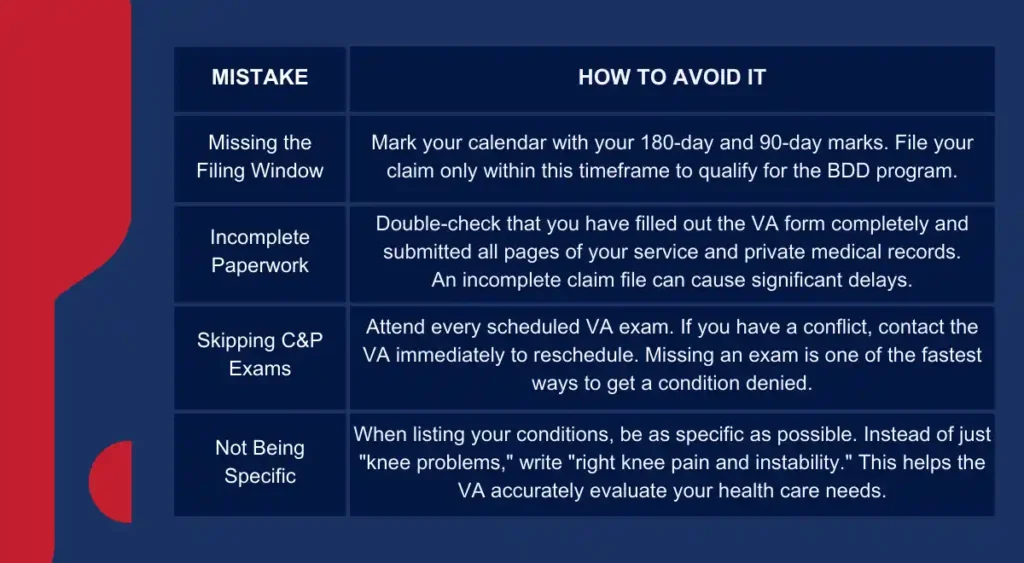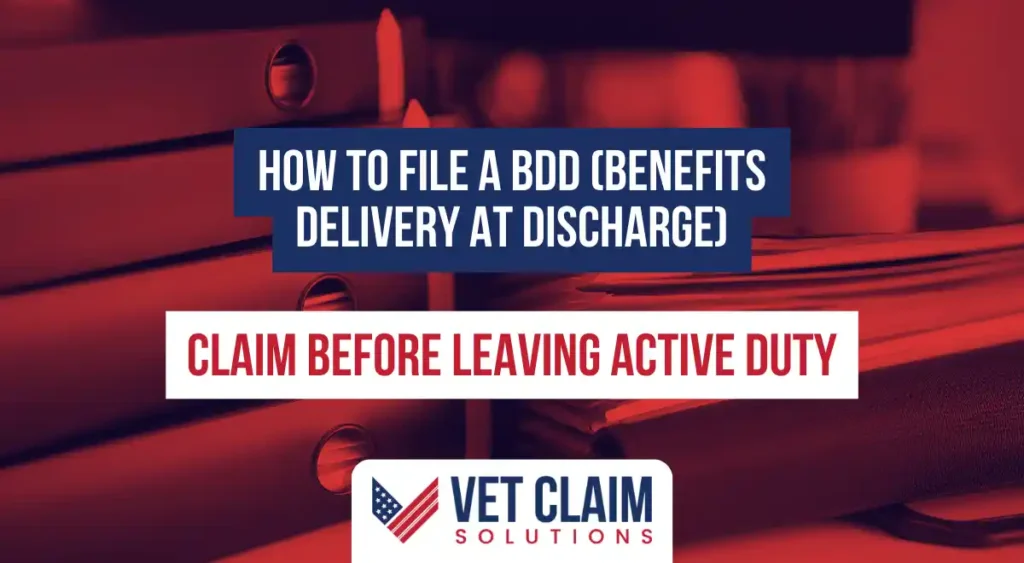Leaving the military is a major life change filled with new opportunities and challenges. As you plan your next steps, figuring out your VA benefits can feel like a complex task with long waits. What if you could get your VA disability benefits started almost as soon as you transition to civilian life? Get VA benefits faster by filing a BDD claim before discharge. Learn if you qualify and how to apply today.
The standard VA claim process can leave you waiting for months without benefits, creating a stressful financial gap. The Benefits Delivery at Discharge (BDD) program helps you avoid this delay. It is a pre-discharge claim option that allows you to get a head start while you are still on active duty.

What Exactly is a Benefits Delivery at Discharge (BDD) Claim?
The BDD program is a specialized process from the Department of Veterans Affairs for service members who are soon to be discharged. It allows you to file for VA disability compensation benefits before your official separation date. This proactive approach is the key to receiving your benefits much more quickly.
With a standard VA claim, you have to wait until after your military service ends to begin the process. The BDD program, however, allows Veterans Affairs to receive your claim and review your Service Treatment Records (STRs) while you are still serving. This lets them schedule your necessary VA exams and gather evidence well before your final day in uniform.
The goal of the BDD program is to provide you with a claim decision soon after you separate. While it may not always be the very next day, it is significantly faster than the months-long decision process for a typical VA disability claim. This helps make your transition smoother and more financially stable.
Are You Eligible for the BDD Program?
The BDD program has specific eligibility requirements, with timing being the most important factor. You must file your claim within a very precise window to qualify. If you are too early or too late, your claim will not be processed through this accelerated program.
To be eligible for filing a BDD claim, you must meet all of the following criteria:
- You are a service member on full-time active duty. This includes members of the National Guard, Guard Reserve, or Coast Guard serving on federal active duty.
- You have a known separation date.
- Your separation date is between 180 and 90 days from the day you file your claim.
- You can provide a copy of your Service Treatment Records for your current period of service with your application.
- You are available for 45 days after filing to attend any required VA exams.

If you file your VA claim with fewer than 90 days remaining on active duty, it will not be handled as a BDD claim. Instead, the VA will process it as a standard claim after you are discharged. This means you will miss out on the speed and efficiency of the BDD process.
Who is Not Eligible for the BDD Program?
Not everyone nearing separation qualifies for the BDD program. Understanding these exclusions can save you time and help you plan accordingly. You are generally not eligible if you:
- Have less than 90 days remaining on active duty.
- Are a member of the National Guard or Reserves not on federal active duty orders.
- Are terminally ill.
- Lost your service records.
- Need to have a VA exam at a foreign VA location (with some exceptions).
- Are pregnant and filing a claim for a condition related to your pregnancy.
If you fall into one of these categories, you can still file for your VA benefits. You will simply need to file a standard VA disability claim after your separation date.
How to File Your BDD Claim: A Step-by-Step Guide
If you meet the eligibility criteria, the next step is to prepare and submit your application. Following these steps carefully will help the claim process go as smoothly as possible. A well-prepared application can lead to a faster claim decision.
Step 1: Gather Your Evidence
The strength of your VA claim depends on your evidence. Your Service Treatment Records (STRs) are the most critical documents you will need. These records show the history of your medical conditions during your military service.
You should also gather any private medical records you have from civilian doctors you saw during your service. These private medical files can provide additional support for your claim. The more documentation you have connecting your medical conditions to your service, the better.
Step 2: Complete Your Separation Health Assessment
Before filing your BDD claim, you will need to complete a Separation Health Assessment (SHA). This health assessment is a crucial part of the process. It involves a medical examination that documents your health at the time you leave the service.
The first part of the SHA is a self-assessment form, the DD Form 2807-1, “Report of Medical History”. You can get an assessment form download online. The second part is a physical exam with a military or VA provider who will complete DD Form 2808, “Report of Medical Examination”.
This separation health process creates an official record of your health status upon leaving the military. It is an important tool for establishing a service-connected condition for your VA claim. Completing this assessment form thoroughly is vital for your initial pre-discharge claim.
Step 3: Fill Out and Submit Your Application
The primary VA form for your disability claim is VA Form 21-526EZ, “Application for Disability Compensation and Related Compensation Benefits”. The easiest and most efficient way to file is online through the VA website. The online system guides you through each section, helping to create a fully developed claim.
You must submit your completed VA form and all supporting documents within the correct timeframe. The window for a BDD claim is between 180 and 90 days before your final day of service. Filing online helps ensure your claim file is received by the VA intake center on time.
Step 4: Attend All VA Exams
After your BDD claim is submitted, the VA will schedule one or more Compensation and Pension (C&P) exams. These appointments are also called VA exams, and they are essential to your claim. A medical professional will evaluate the medical conditions you claimed to determine their severity and connection to your service.
You must attend every scheduled VA exam. If you miss an appointment without notifying the VA, they could deny your claim for that specific condition. These exams are usually scheduled at a VA medical center or a contracted clinic near your duty station.

What Conditions Can You Claim Through BDD?
You can claim any physical or mental health condition that you believe was caused or worsened by your military service. There is no limit on the number of medical conditions you can list in your initial pre-discharge claim. The key is to provide evidence showing a service-connected disability.
Some of the most common conditions claimed by separating service members include:
- Tinnitus and hearing loss.
- Musculoskeletal issues like back, knee, or shoulder pain.
- Post-Traumatic Stress Disorder (PTSD) and other mental health conditions.
- Radiculopathy (nerve pain shooting down your arms or legs).
- Migraine headaches.
- Scars from injuries or surgery.
- Sleep apnea and other respiratory issues.
Your STRs should show that you sought treatment or were diagnosed with these conditions while on active duty. This documentation makes it much easier for the VA to establish a service-connected condition. If a condition is not in your records, you may need additional evidence, like statements from people you served with.
Common Mistakes to Avoid When Filing a BDD Claim
The BDD program is a great opportunity, but simple mistakes can cause delays or result in your claim being processed as a standard one. Being aware of these common issues can help you avoid them. A smooth claim process starts with a careful application.
Here are some mistakes to watch out for:

What Happens After You File?
Once you have submitted your BDD claim, the VA regional office will begin its work. You will receive a letter or notification confirming that they have received your application. The next major step will be the scheduling of your C&P exams.
While you attend your exams and complete your final months of service, the VA is developing your claim. After you officially separate, the VA can finalize its review and make a decision. The goal of the BDD process is to get this decision to you as quickly as possible.
In addition to disability compensation, this is a good time to explore other benefits like Veteran Readiness and Employment (VR&E). This program offers services to help veterans with service-connected disabilities prepare for and find suitable employment. Filing a BDD claim can help you access these and other benefits sooner.
Conclusion
Transitioning from the military is a demanding period, and waiting for VA benefits should not add to the stress. The Benefits Delivery at Discharge program provides a clear path to receiving your disability compensation close to your separation date. This can make a significant difference in your financial security as you begin your civilian life.
Success with the BDD program comes down to proper timing and thorough preparation. By understanding the rules, gathering all your medical evidence, and filing within the 180 to 90-day window, you can set yourself up for a quick decision. You can get VA benefits faster by filing a BDD claim before discharge, so learn if you qualify and start your application today.


